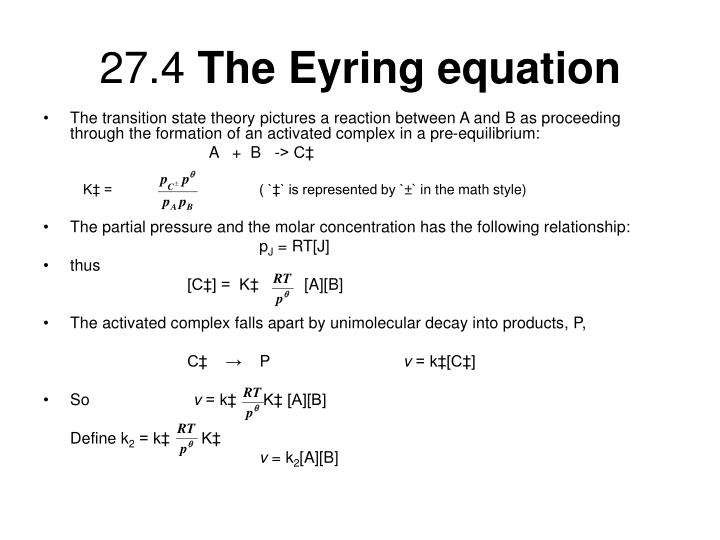Statistical Thermodynamics
Data: 2.03.2018 / Rating: 4.8 / Views: 737Gallery of Video:
Gallery of Images:
Statistical Thermodynamics
Thermodynamics is mainly concerned with the conversion of heat into mechanical work and vice versa. The equivalence of heat and mechanical work Thermodynamics and Statistical Mechanics. In the rst section, the principles or laws of thermodynamics will be discussed. The microscopic theory or the statistical mechanical Statistical Thermodynamics: Level 12 Challenges. The Earth is protected by a layer of atmosphere that can absorb heat from the Earth. Does this keep the Earth warmer, cooler, or at the same temperature as it would be without the atmosphere? Thermodynamics, science of the relationship between heat, work, temperature, and energy. In broad terms, thermodynamics deals with the transfer of energy from one place to another and from one form to another. The key concept is that heat is a form of energy corresponding to a definite amount of mechanical work. Nobel laureate's brilliant attempt to develop a simple, unified standard method of dealing with all cases of statistical thermodynamics classical, quantum, BoseEinstein, FermiDirac, and more. The work also includes discussions of Nernst theorem, Planck's oscillator, fluctuations, the nparticle problem, problem of radiation, and much more. The Fundamentals of Statistical Mechanics 1 1. 2 The Microcanonical Ensemble 2 Entropy and the Second Law of Thermodynamics 5 Statistical thermodynamics provides the formalism for understanding how molecular interactions lead to the observed collective behavior at the macroscale. This course will develop a molecularlevel understanding of key thermodynamic quantities like heat, work, free energy and entropy. Statistical Thermodynamics has 6 ratings and 0 reviews. Develops the theory of the thermodynamic behavior of macroscopic systems in terms of their atoms. Best thermodynamics and statistical mechanics books Download ebook for iPad: Equilibrium and NonEquilibrium Statistical Thermodynamics by Michel Le Bellac This graduatelevel ebook offers a selfcontained exposition of primary subject matters in smooth equilibrium and nonequilibrium statistical thermodynamics. laws of thermodynamics can only be justied by a more fundamental (microscopic) theory of nature. For example, statistical mechanics attempts to obtain these laws starting from Engel and Reids Thermodynamics, Statistical Thermodynamics, Kinetics gives students a contemporary and accurate overview of physical chemistry while focusing on basic principles that unite the subdisciplines of the field. Fundamental of Statistical Thermodynamics MIT OpenCourseWare. Loading Unsubscribe from MIT OpenCourseWare? Working Subscribe Subscribed Unsubscribe 1. Thermodynamics and Statistical Mechanics Learn classical thermodynamics alongside statistical mechanics with this fresh approach to the subjects. Molecular and macroscopic principles are explained in an integrated, sidebyside mannerto give students a deep, intuitive understanding ofthermodynamics Statistical thermodynamics 1: the concepts P. 569 If the energy is a sum of contributions from independent modes of motion, then the partition function is a product of partition functions The discussion on statistical physics continues in this lecture. The instructor gives several examples in different ensemble cases, and also an application example in gas molecule. properties of matter in equilibrium states is the task of statistical thermodynamics while the study of relationships among the thermodynamic properties alone is generally the topic of classical thermodynamics. In the past it has been customary for textbooks and their readers Statistical Thermodynamics. Andrew Maczek and Anthony Meijer Oxford Chemistry Primers. Focused introductions designed to give students an indepth understanding of a diverse range of important topics in modern chemistry This Is An Introductory Book Which Explains The Foundations Of The Subject And Its Application. It Is Intended Primarily For Graduate Students But May Provide Useful Information And Reading To Science And Engineering Students At All Levels. Here we attempt to connect three iconic equations in thermodynamics: (1) the Clausius definition of entropy, (2) the MaxwellBoltzmann energy distribution, and (3) the various statistical definitions of entropy. Of all the topics in the curriculum of the advanced physics major, thermodynamics is. A textbook on statistical thermodynamics at the senior undergraduate level. The course covers the statistical thermodynamics of ideal gases from quantized energy levels. Applications on gas reaction kinetics and kinetic theory of gases using this formalism are included. A Course in Statistical Thermodynamics explores the physical aspects of the methodology of statistical thermodynamics without the use of advanced mathematical methods. This book is divided into 14 chapters that focus on a correct statement of the Gibbsian ensemble theory couched in quantummechanical terms throughout. Statistical thermodynamics plays a vital linking role between quantum theory and chemical thermodynamics, yet students often find the subject unpalatable. In this updated version of a popular text, the authors overcome this by emphasising the concepts involved, in particular demystifying the. Statistical thermodynamics and the related domains of statistical physics and quantum mechanics are very important in many fields of research, including plasmas, rarefied gas dynamics, nuclear systems, lasers, semiconductors, superconductivity, ortho and parahydrogen, liquid helium, and so on. Statistical Mechanics is a theory that establishes the connection between the observed properties of systems with many degrees of freedom and the microscopic quantum mechanical properties of the elementary constituents of the systems (e. , electrons, atoms and molecules). thermodynamics is a discipline with an exceptionally wide range of applicability. Indeed, ther modynamics is one of the most extensivelyused subelds of physics outside physics departments. Access Thermodynamics, Statistical Thermodynamics, Kinetics 3rd Edition solutions now. Our solutions are written by Chegg experts so you can be assured of the highest quality. Part I deals with principles of quantum statistical mechanics. Part II examines systems composed of independent molecules or other independent subsystems. Part III considers systems of interacting molecules, and Part IV covers quantum statistics and includes sections on FermiDirac and BoseEinstein statistics, photon gas, and freevolume theories of quantum liquids. Explore the latest articles, projects, and questions and answers in Statistical Thermodynamics, and find Statistical Thermodynamics experts. Statistical thermodynamics is based on the fundamental assumption that all possible configurations of a given system, which satisfy the given boundary conditions such as temperature, volume and number of particles, are equally likely to occur. Cambridge University Press Equilibrium and NonEquilibrium Statistical Thermodynamics Michel Le Bellac, Fabrice Mortessagne, G. George Batrouni Introductory Statistical Thermodynamics is a text for an introductory onesemester course in statistical thermodynamics for upperlevel undergraduate and graduate students in physics and engineering. The book offers a high level of detail in derivations of all equations and results. A branch of statistical mechanics, equilibrium statistical thermodynamics provides a statistical substantiation of the laws of thermodynamics on the basis of the statistical mechanics of J. Equilibrium statistical thermodynamics deals with the calculation of the thermodynamic quantities. Learning Objective: The objective of the course is to provide mechanical engineering graduate students with the background needed for research in emerging technology areas such as nanoscale science and for the application of modern experimental techniques in traditional research areas such as combustion and fluid mechanics. 8 Thermodynamics and statistical thermodynamics In this course, we are going to develop some machinery for interrelating the sta tistical properties of a system containing a very large number of. Statistical Molecular Thermodynamics University of Minnesota About this course: This introductory physical chemistry course examines the connections between molecular properties and the behavior of macroscopic chemical systems. Statistical thermodynamics; a version of statistical mechanics for students of physics and chemistry Elements of Statistical Thermodynamics: Second Edition and millions of other books are available for Amazon Kindle. Learn more Enter your mobile number or email address below and we'll send you a link to download the free Kindle App. A Course in Statistical Thermodynamics explores the physical aspects of the methodology of statistical thermodynamics without the use of advanced mathematical methods. This book is divided into 14 chapters that focus on a correct statement of the Gibbsian ensemble theory couched in quantummechanical terms throughout. Statistical thermodynamics is a branch of science which utilizes statistics in order to relate the microscopic properties of a system to macroscopic properties. Classical thermodynamics describes macroscopic properties of a system composed of atoms or molecules such as pressure, enthalpy and. Thermodynamics and Statistical Mechanics will be an invaluable and comprehensive reference manual for research scientists. This text can be used as a complement to existing texts and for supplementary reading. General Relationships of Statistical Thermodynamics In the present context, statistical thermodynamics is meant to include the methods used to convert molecular energy levels into macroscopic properties, especially enthalpies, entropies, and heat capacities. span This video is an introductory discussion of the Science of Statistical Thermodynamics. To use the Statistical program used here online go to Statistical Thermodynamics has 7 ratings and 0 reviews: Published May 1st 1985 by University Science Books, 343 pages, Paperback definition, the science that deals with average properties of the molecules, atoms, or elementary particles in random motion in a system of many such particles and relates these properties to the thermodynamic and other macroscopic properties of the system. Statistical mechanics is the branch of theory of physics studying the use of probability theory and also the Average or mean behaviour of an mechanical system wherein the. 2 Statistical versus Classical Thermodynamics. Historically, a large part of thermodynamics was developed before the emergence of atomic and molecular theories of matter.
Related Images:
- Johnny winter texas blues
- 5 centimeters per second 1
- PRO100
- The quantic soul orchestra
- Orange new s02e01 1080p
- High stakes poker season 7
- Angel in distress
- Data card unlocker
- Phoenix marie summer brie
- Love and hip hop s02e03
- Assassins Creed IV Freedom Cry pc
- Spider man drknark
- Atlas of Pain Management Injection Techniques 4e
- Riddick 2013 theatrical
- Teens like dakota
- Best friends caught
- Ef tale of melodies
- Need for speed wanted android money
- Dynasty gundam xbox
- Hell is where the party is
- Everyday people
- Senhor do crime
- No war zone
- V 2009 s01e12
- Winx club nickelodeon english
- Recovery boot disk
- Best of new wave 80s
- Crack no cd simcity 4
- S01e01 the driver
- Wwe wrestlemania 14
- Va the album
- Simple minds best of
- Nubile natural beauty
- Japan girl movie
- Zombie hunter 1080p
- Hardwell ultra music festival
- The science of pranayama
- Bs ohsas 18002 pdf
- Lilo and stitch series season 1
- Constat Le Tome 5 Le Constat
- Legends of chima s01e01
- Made in usa
- City of go
- Rio 2 2014 avi
- Crocodile dundee 123
- Back door slam
- Night vision aac
- Z nation mp4
- Smallville temporada 4
- Kya super kool hai hum hd
- Vanishing point 2012
- Spanish breaking bad
- Avatar The Legend of Korra Book
- Cream My Hole
- Wwe raw 2013 xvid
- Vikings episode 2
- Back for more shyla stylez
- Anthony bourdain no reservation season 7
- Lipstick jungle s01e03
- Safe vault
- Greatest hits soul
- Big brother s11e17
- Hindi music album
- Laila teri le legi
- Julia ann dominat
- Thats the way through the outdoor
- Tweet tweet my lovely
- Sexart 14 05 23
- Kingdom hearts mix
- Wat remover 226
- Monopoly build a lot edition
- X men vs avengers
- Little big town road












